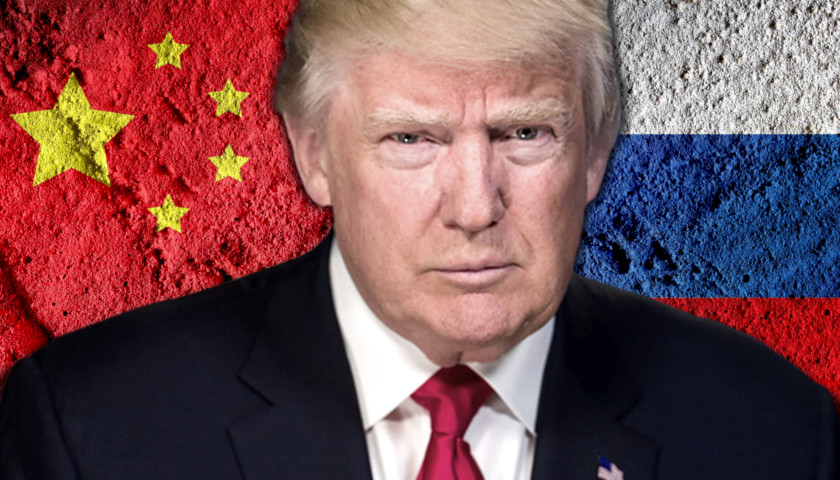by Edward Ring
America was at a historic crossroads in 1971. The war in Vietnam increasingly was seen as unwinnable, while triggering ongoing unrest in cities and college campuses across the nation. The economy was challenged with rising inflation and rising trade deficits. In August 1971, the British ambassador turned up at the Treasury Department to request that $3 billion be converted into gold. That same week, President Nixon ordered a freeze on all prices and wages in the United States.
In the Communist world, America’s problems were trumpeted as the inevitable collapse of capitalist imperialism. Russia and China stood triumphant over a declining West. And what did Nixon do? He stunned the world by traveling to China. His goal: To drive a wedge between the two Communist superpowers.
Historians can speculate endlessly over what might have happened had Nixon never played the China card. But his strategy, to keep China and Russia from getting too close, has more applicability today than it did nearly 50 years ago.
Today, Russia and China continue an alliance that has fitfully endured over the decades. In recent years, especially since oil prices have fallen, Russia has supplied China with raw materials and high technology in exchange for desperately needed cash. Even now, China is only beginning to acquire sufficient skill to manufacture high-performance jet engines for its military, and still has to rely on Russian aerospace manufacturers to fill the gap.
That China and Russia are both undemocratic nations that continue to oppress their own citizens while threatening neighboring nations is beyond serious debate, but together they are a formidable partnership. Just in terms of territory, the two nations and their client states occupy well over 70 percent of the entire Asian landmass. Russia’s natural resources and China’s population, plus the technological prowess of both nations, make them peer competitors to the United States. Whatever threat they constituted 50 years ago is only magnified today.
Similarly, the United States faces military and economic challenges on par, if not worse, than those it faced 50 years ago. It is again mired in overseas conflicts, most notably in Afghanistan but also via the war on terror being waged on countless fronts around the world. Economically the United States has just exponentially increased its deficit spending, using the Federal Reserve to monetize debt, threatening the stability of the U.S. dollar on global currency markets.
China and Russia United Pose an Existential Threat to the U.S.
The United States confronts two grim scenarios in the 2020s that cannot be ignored. The United States can cede its military supremacy by virtue of being leapfrogged both quantitatively and qualitatively in strategic weapons development. And the U.S. dollar can be replaced as the world’s reserve and transaction currency by a foreign currency union that melds a market currency with some combination of cyber and precious metal collateral. Either of these outcomes would cripple the ability of the United States to access global markets, and in turn, would lead to catastrophic economic turmoil. The only way either of these objectives likely can be achieved is if China and Russia work together to achieve them.
This is the context in which the blather over alleged Russian-paid bounty hunters operating in Afghanistan dominate the news in America. While tragic, it is a tactical issue. In scope, if not in terms of the exact details, it is nothing new. Russia and the United States have not been at peace in modern history. Even during World War II, Russia was more of a third force than an ally. The Poles who were massacred by the Russians in the Katyn forest in 1940 would agree, as would the Poles who were liquidated by the Nazis in the Warsaw uprising in the Fall of 1945, as Russian troops waited on the other side of the Vistula River for the Germans to do their dirty work for them.
What the United States must decide is not whether Vladimir Putin is a good guy, or whether Russia can be trusted. We already know the answer to those questions. The prevailing question is simply this: Which nation presents a greater threat to the United States—Russia or China? And to that question, there is only one unequivocal answer: China is now the greater threat.
By now it should be clear to Americans that China is bent on global hegemony and has the capacity and will to achieve it. For too many years, however, and even now, China has skillfully reallocated the more than $5 trillion in its accumulated trade surplus with the United States to purchase not only our assets and our technology, but also our journalists, our professors, our actors and athletes, our investors, our corporate boards, and our politicians.
By comparison, Russia’s financial clout is insignificant. This explains most if not all of America’s establishment fixation on bashing Russia, and only begrudgingly holding China accountable. Perhaps China’s willful decision to neglect containing the coronavirus has done the West, and the rest of the world, a big favor. At last America’s over-dependence on China’s manufacturing prowess is widely understood, as is an awareness that China is not our friend. This fact may still be lost on the protesters wearing BLM t-shirts sewn by slaves in Xinjiang, but the rest of us get it.
China Poses a Bigger Threat to Russia than the U.S.
While Vladimir Putin’s popularity may have declined somewhat among the Russian people, what he represents to them is undiminished.
Putin speaks to the historical memory of the Russian people, whose territory has been invaded repeatedly over the centuries. The fact that Russia was an imperialist nation that successfully absorbed Central Asia, Eastern Europe, the entirety of Siberia and even a huge slice of North America does not erase Russian insecurity. The Russian people will never forget that the Germans nearly wiped them out in the early 1940s. They feel additional uncertainty over the loss of occupied Eastern Europe at the end of the Cold War, and the decision by Gorbachev to grant independence to the Central Asian republics.
Putin, like Stalin, or, for that matter, Catherine the Great and Ivan the Terrible, gives Russians the reassurance that their leader will stand up to foreign threats. And when it comes to foreign threats, China, not America, is what Russians ought to be worrying about.
Consider the populations of these two nations: Russia with 144 million, China with 1.4 billion, 10 times as many people. Consider the GDP of these two nations: Russia at $1.7 trillion, China at $13.6 trillion, eight times as much. According to two of the most fundamental measurements of a nation’s size and strength, China dwarfs Russia.
Consider the shared border between China and Russia, over 2,500 miles, mostly in the Russian Far East. North of this border, within Russia, is outer Manchuria, annexed by Russia from China in 1858. How many Russians live in their eastern districts? In Siberia, 19.9 million. In the Far East, 6.6 million. And just across the border, 1.4 billion Chinese, over 110 million of them just in Manchuria.
Within Russia’s vast and virtually empty eastern districts are natural resources of staggering immensity and of absolutely vital importance to China’s growing economy. Not only are the Russians economically dependent on exporting these raw materials to China, but they are demographically incapable of doing the work themselves. There aren’t enough Russians in Russia to serve the Chinese appetite for Russian raw materials.
For this reason, millions of Chinese are living in Russia, or are about to be living in Russia. The Chinese are purchasing Russian land, farming in Russia, building factories on Russian soil, and migrating into Russia. The Chinese aggressively seek opportunities to exploit resources on Russian territory in the Arctic. How long will the Russians risk the loss of their sovereignty to China? How long will China tolerate Russian control over territory they dominate demographically, economically, and to which they even have a historical claim?
The Russia Card
Americans have endured a mostly healthy internal conflict between principled diplomacy and realpolitik for decades. It is a tribute to the goodness of Americans that realpolitik does not always dominate our foreign policy—that concern for human rights, democracy, environmental protection, and international rule of law are equally prominent in our foreign policy discussions. But international politics, just like domestic politics, requires compromises.
America’s experience with Russia in recent decades includes encouraging facts. Russia gave up its Eastern European buffer states without a fight. It reinstated its parliament and began to experiment with democracy. Although Putin has revived authoritarian rule, his popularity can partly be attributed to America’s failure to live up to its part of the bargain made with Gorbachev in 1990. America promised not to extend NATO into Eastern Europe and then proceeded to do just that.
None of this is to make excuses for Russia. But the media hacks that read any balanced appraisal of the U.S.-Russia relationship as an unforgivable endorsement of the Russian regime are doing America a disservice. There is nothing the Chinese (and the American businesses and investors who get rich doing business with China) would like better than to keep the focus of American animus on Russia. This is a terrible betrayal of America’s long-term interests.
Playing the Russia card does not mean Americans suddenly become allies of Russia and support everything President Putin does. It merely recognizes geopolitical facts. China is a far bigger threat to America than Russia. China, unlike Russia, can take over the world, but their path to that ultimate victory will be far more difficult if Russia does not help them. And China poses a greater long-term threat to Russia than America does.
So enough already, New York Times, and all the rest of the China apologists. Yes, tensions with Russia are ongoing. Russia does bad things. But when it comes to threats to America, China must be our overwhelming focus. And playing the Russia card would shake them to their core.
– – –
Edward Ring is a senior fellow of the Center for American Greatness and co-founder of the California Policy Center, which he co-founded in 2013.





